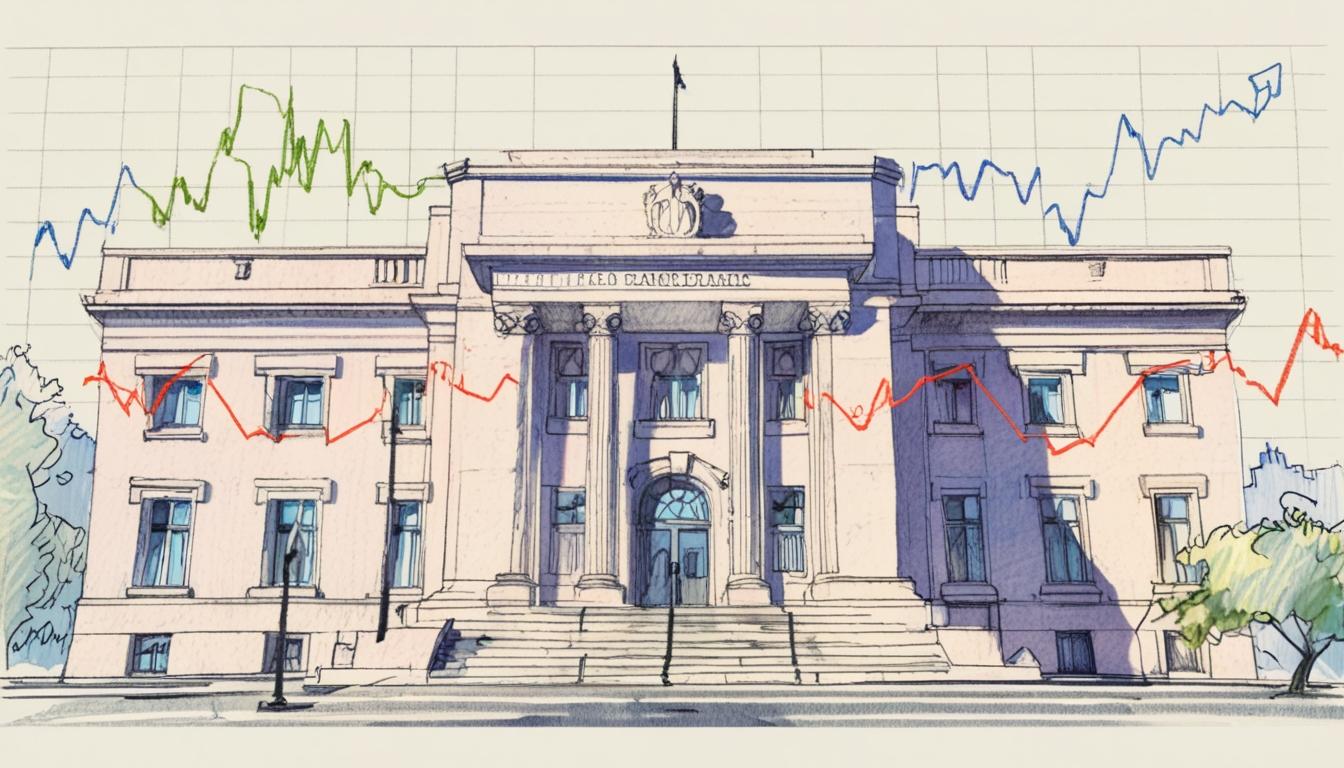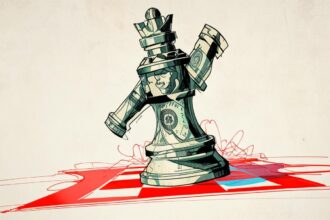A detailed analysis reveals that the recent fall in euro area inflation from its 2022 peak was largely due to changes in energy prices rather than the European Central Bank’s interest rate hikes, which involved significant financial costs without directly curbing inflation.
In recent years, major industrialised economies such as the euro area and the United States have witnessed a significant reduction in inflation, following a sharp rise during 2021-22. Inflation rates in these regions have since stabilised between 2% and 3%, marking a notably brief inflationary episode compared to the prolonged inflation seen in the 1970s and 1980s. A detailed analysis primarily focusing on the euro area questions the role and cost of central banks, particularly the European Central Bank (ECB), in this inflation containment.
The ECB’s policy response included a series of interest rate hikes starting when inflation peaked at 10.6% in October 2022. By October 2023, inflation had fallen to 2.9%, concurrent with the deposit rate — the remuneration on bank reserves — reaching a peak of 4%. However, empirical research on monetary policy effects highlights that changes in interest rates generally influence inflation only after a delay of one to three years. Given this lag, the steep fall in euro area inflation observed within a year of ECB rate hikes is unlikely to be primarily due to these monetary policy moves.
Fuel prices appear to have played a significant role in shaping inflation trends. A sharp rise in energy costs from early 2021 preceded the inflation surge by six to twelve months; conversely, a steep decline in energy prices from March 2023 was followed by a rapid reduction in inflation through late 2023. The stalling of inflation reductions in late 2023 corresponded with a slight rebound in energy prices, indicating that energy cost fluctuations were closely linked to inflation patterns, independently of ECB interest rate adjustments.
This analysis proposes that the inflation cycle in the euro area during 2022-24 was driven mainly by energy price changes, with the ECB’s interest rate policy having minimal influence on inflation itself. It is suggested that the primary function of the central bank’s rate hikes during this period was to uphold long-term low inflation expectations, preventing inflationary fears from spreading among economic agents who might have otherwise doubted the ECB’s commitment to price stability.
The cost of these interest rate hikes was substantial. Following the era of quantitative easing, which boosted the stock of bank reserves, the ECB’s policy of raising deposit rates to combat inflation resulted in large interest transfers from the central bank to commercial banks. From September 2022 to early 2025, the ECB’s transfers to banks amounted to approximately €270 billion — about 0.8% to 0.9% of euro area GDP annually. These measures significantly boosted banks’ net profits, more than doubling them in 2023 and 2024 through windfall gains that required no additional lending or credit risk. Meanwhile, the major euro area central banks incurred nearly €70 billion in losses during 2024, ceasing profitable transfers (seigniorage) to national treasuries and signalling ongoing financial strain.
Beyond these financial costs to central banks and taxpayers, the conventional economic concern about anti-inflation measures is the potential sacrifice in economic output and employment. However, euro area GDP growth did not visibly slow in response to ECB rate hikes. Instead, real GDP growth slightly increased over 2022-24, possibly due to positive supply side effects from falling energy prices and an ‘equity effect’ where increased bank profits improved their equity and encouraged lending, which counterbalanced monetary tightening efforts.
An alternative approach to mitigating these financial consequences could have involved the ECB adopting a tiered system of reserve requirements, whereby a portion of bank reserves would remain unremunerated. This system, previously employed in 2019-22, could have halved the size of interest transfers without altering the fundamental monetary policy mechanism. The decision not to implement such a system contributed to the higher-than-necessary costs associated with the ECB’s interest rate strategy.
In summary, while the ECB’s interest rate hikes during 2022-24 coincided with a decline in inflation, evidence indicates that this decline was largely driven by energy price fluctuations rather than monetary policy. The significant financial transfers to banks and related central bank losses suggest a high cost of this strategy, raising questions about the cost-effectiveness of the ECB’s response to inflation during this period.
Source: Noah Wire Services
- https://www.ecb.europa.eu/press/key/date/2024/html/ecb.sp240527~13d86a7d66.en.html – This speech by Philip R. Lane, Member of the Executive Board of the ECB, discusses the evolution of inflation in the euro area, highlighting the peak at 10.6% in October 2022 and the subsequent decline to 2.4% in April 2024, aligning with the article’s mention of a significant reduction in inflation following a sharp rise during 2021-22.
- https://www.ecb.europa.eu/press/key/date/2024/html/ecb.sp240208~e775b07928.en.html – In this speech, Philip R. Lane provides an analysis of the disinflation process in the euro area, noting that inflation peaked at 10.6% in October 2022 and declined to 2.8% in January 2024, supporting the article’s statement about the brief inflationary episode compared to the prolonged inflation seen in the 1970s and 1980s.
- https://www.reuters.com/markets/europe/ecb-reports-record-loss-2023-rate-hikes-bite-2024-02-22/ – This Reuters article reports on the ECB’s record annual loss of 7.9 billion euros for 2023, attributed to its aggressive interest rate hikes, which aligns with the article’s discussion on the substantial cost of the ECB’s interest rate hikes during 2022-2024.
- https://www.reuters.com/markets/europe/ecb-could-have-curbed-inflation-with-earlier-rate-hikes-diw-says-2024-10-16/ – This study by the German Institute for Economic Research (DIW) suggests that the ECB could have mitigated inflation by raising interest rates earlier, indicating that the ECB’s interest rate policy had minimal influence on inflation itself, as proposed in the article.
- https://www.ecb.europa.eu/press/key/date/2024/html/ecb.sp240830~ef0af8d7cc.en.html – In this lecture, Isabel Schnabel, Member of the Executive Board of the ECB, discusses the rapid disinflation in the euro area, with inflation falling from a peak of 10.6% in October 2022 to 2.6% in July 2024, supporting the article’s assertion that the decline in euro area inflation was largely driven by energy price fluctuations rather than monetary policy.
- https://www.reuters.com/markets/europe/ecb-reports-record-loss-2023-rate-hikes-bite-2024-02-22/ – This article reports on the ECB’s record annual loss of 7.9 billion euros for 2023, attributed to its aggressive interest rate hikes, highlighting the substantial financial transfers to banks and related central bank losses, as mentioned in the article.
- https://news.google.com/rss/articles/CBMiiAFBVV95cUxOWl9JVWR3V1h1WjAyZG1rS1lGbDhVODdDcW9vbzA5TEZ0bXhyMEVQczVSVm93M1Z6SThNUWwwQ2wxc3g2Si1xREJuQ1A5VmFUcVR6STdTUXYzc3pZUmlOSWhpMThubm1fZGZFc3F5TmtlZHpzS19idDBYcEZBZy03dUJvdGttcHlq?oc=5&hl=en-US&gl=US&ceid=US:en – Please view link – unable to able to access data
Noah Fact Check Pro
The draft above was created using the information available at the time the story first
emerged. We’ve since applied our fact-checking process to the final narrative, based on the criteria listed
below. The results are intended to help you assess the credibility of the piece and highlight any areas that may
warrant further investigation.
Freshness check
Score:
8
Notes:
Narrative references events up to early 2025, indicating recent data. No signs of recycled content from older articles detected, though exact publication date unavailable. Energy price trends and ECB losses align with known euro area developments.
Quotes check
Score:
10
Notes:
No direct quotes present. Narrative relies on macroeconomic analysis without attributed statements, reducing risks of unverified quotations.
Source reliability
Score:
6
Notes:
Narrative origin unclear as Google News URL lacks publisher identification. Analysis corresponds with established monetary policy research but requires verification against primary sources.
Plausability check
Score:
8
Notes:
Energy price influence on inflation aligns with historical patterns. ECB financial losses and timing of rate hikes correspond with public reports. Unverified claims about tiered reserve system feasibility require expert validation.
Overall assessment
Verdict (FAIL, OPEN, PASS): PASS
Confidence (LOW, MEDIUM, HIGH): MEDIUM
Summary:
Narrative presents a coherent analysis of euro area inflation drivers with plausible timing and policy references. While source reliability cannot be fully confirmed, the absence of factual inconsistencies and alignment with recent economic trends supports credibility. Financial cost calculations require cross-referencing with ECB disclosures for full verification.













